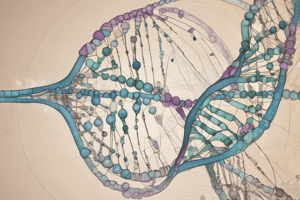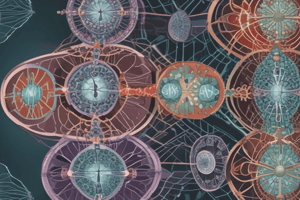Podcast
Questions and Answers
What is the primary function of genes found in DNA?
What is the primary function of genes found in DNA?
- Support cellular membranes
- Create carbohydrates
- Energy production
- Code for proteins (correct)
Why are sex-linked genetic mutations more likely to occur in males?
Why are sex-linked genetic mutations more likely to occur in males?
- Males have only 1 X chromosome (correct)
- Males inherit more genetic mutations
- Males have two X chromosomes
- Males only receive Y chromosomes
What type of trait is controlled by multiple genes on different chromosomes?
What type of trait is controlled by multiple genes on different chromosomes?
- Monogenic trait
- Incomplete trait
- Simple trait
- Polygenetic trait (correct)
What is the expected probability of children having black hair if one parent is homozygous recessive for blond hair and the other is heterozygous for black hair?
What is the expected probability of children having black hair if one parent is homozygous recessive for blond hair and the other is heterozygous for black hair?
Which nucleotide is not present in RNA?
Which nucleotide is not present in RNA?
What characterizes the blood type AB in humans?
What characterizes the blood type AB in humans?
What is indicated if all alleles for a specific trait are the same in a population?
What is indicated if all alleles for a specific trait are the same in a population?
How do carbohydrates on blood cells influence blood type?
How do carbohydrates on blood cells influence blood type?
What is convergent evolution?
What is convergent evolution?
What does a genetic mutation depend on?
What does a genetic mutation depend on?
What is microevolution?
What is microevolution?
What is the primary focus of the biological species concept?
What is the primary focus of the biological species concept?
What is the defining factor for a species' niche?
What is the defining factor for a species' niche?
In ecological studies, which interaction is characterized by a positive impact on one species and no impact on the other?
In ecological studies, which interaction is characterized by a positive impact on one species and no impact on the other?
Which of the following best describes climate change?
Which of the following best describes climate change?
What does community succession refer to?
What does community succession refer to?
Flashcards
Genotype and Phenotype
Genotype and Phenotype
Genotype refers to the genetic makeup of an individual, while phenotype refers to the observable traits or characteristics expressed by that genotype.
Polygenic Trait
Polygenic Trait
A polygenic trait is influenced by multiple genes located on different chromosomes.
Sex-Linked Traits
Sex-Linked Traits
Males have one X chromosome and one Y chromosome, while females have two X chromosomes. A single recessive allele on the X chromosome will cause a sex-linked trait in males.
Genes and Proteins
Genes and Proteins
Signup and view all the flashcards
Transcription and Translation
Transcription and Translation
Signup and view all the flashcards
RNA vs. DNA
RNA vs. DNA
Signup and view all the flashcards
Allele Frequency
Allele Frequency
Signup and view all the flashcards
Natural Selection
Natural Selection
Signup and view all the flashcards
Microevolution
Microevolution
Signup and view all the flashcards
Macroevolution
Macroevolution
Signup and view all the flashcards
Convergent Evolution
Convergent Evolution
Signup and view all the flashcards
Ecological Fitness
Ecological Fitness
Signup and view all the flashcards
Ecology
Ecology
Signup and view all the flashcards
Niche
Niche
Signup and view all the flashcards
Dispersion
Dispersion
Signup and view all the flashcards
Study Notes
Genetics
- Genotypes influence phenotypes: Genotypes (genetic makeup) determine phenotypes (observable traits).
- Polygenic traits: Traits controlled by multiple genes on different chromosomes.
- Sex-linked mutations: Mutations on sex chromosomes (X) are more common in males due to having only one X chromosome.
- DNA and protein production: DNA codes for proteins.
- Transcription vs. translation: Transcription creates mRNA from DNA; translation uses mRNA to create proteins.
- RNA nucleotides: RNA lacks thymine; it contains uracil instead.
- Allele frequency: Allele frequency cannot change in an individual.
- Natural Selection: The process where organisms better adapted to their environment survive and reproduce more successfully.
- Homozygous recessive/heterozygous pairing: If one parent is homozygous recessive (e.g., bb for blond hair) and the other heterozygous (e.g., Bb for black hair), there is a 50% chance a child will have black hair.
- Blood type alleles: Blood type A can result from either homozygous AA or heterozygous AO genotypes.
- Blood type codominance: Blood type AB is due to codominance (both Iᴬ and Iᴮ alleles are expressed).
- Blood type carbohydrates: Carbohydrates on blood cells determine blood type (antigens). Blood type O has no A or B antigens.
Evolution
- Natural selection and allele frequency: Natural selection cannot occur if all alleles are the same.
- Convergent evolution: Distant relatives can look/act similar when adapting to similar environments.
- Ecological fitness and reproduction: Higher ecological fitness results in more offspring.
- Genetic mutations: Mutations can be harmful, beneficial, or neutral.
- Microevolution vs. macroevolution: Microevolution is small-scale changes within a species; macroevolution involves the creation of new species.
- Stabilizing selection: A shift in allele frequency where extremes are lost, and average traits become more common.
- Allopatric speciation: Speciation that occurs due to geographic isolation.
- Biological species concept: Species are defined by the ability to interbreed successfully.
- Sexual selection: Mate choice is a form of natural selection.
Ecology
- Ecology definition: The study of interactions between organisms and their environment.
- Species niche: A species' niche is defined by both abiotic (non-living) and biotic (living) factors.
- Population dispersion: Random dispersion is when individuals are scattered randomly in an area.
- Endemic vs. cosmopolitan species: Endemic species face a higher extinction risk.
- Species interactions (ecological): Two species living in same area can coexist if niche overlap is limited.
- Commensalism: A symbiotic relationship where one species benefits, and the other is neither benefitted nor harmed.
- Ecosystem ecology focus: Ecosystem ecologists examine energy flow and nutrient cycling (e.g., nitrogen and carbon).
Climate Change
- Climate change cause: Primarily caused by releasing carbon dioxide from burning fossil fuels.
Studying That Suits You
Use AI to generate personalized quizzes and flashcards to suit your learning preferences.




